Although it may strike a theorist as paradoxical, the artist’s sole response to a moment such as ours—with its ideological cowardice, its reflexive violence, its prurient spectatorship—is always to exult in using the most voluptuous and rigorous resources at hand, to offer the public something that will be the equal of our condition, with unbounded patience and tenderness, in the service of an open luxuriance of the imagination, a lavish strictness, an arduous delight, which everyone shares, no matter how fully or for how long the sensate mind we all have in common might be suppressed or forgotten. In the paintings of David de Biasio, we encounter a general circumstance as it appears in the reflection of an exquisitely refined sensibility, as if the mental eye were cleansed of expectancy and reminiscence, and we saw through disappointment and joy like so much glass, to the things beyond them: these artworks induce an alternate, creative condition in viewers by which we, along with the artist, realize the inapprehensible in images, suspending belief and disbelief.
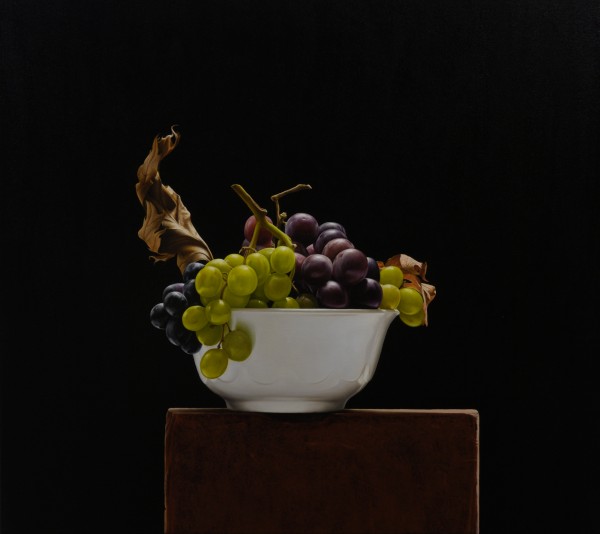
With their subtly pure yet pervasive and obstinate artistry, de Biasio’s paintings recall the offhand charm of Chardin or the clinical ardor of Cotán. In this respect it makes sense when we read that Alberto Agazzani feels de Biasio’s style is “so totally arrogant in its perfection and in the stupefying play of light, shadows, and reflections, that it defies any attempt at a reading in any way hyperrealist.” If Agazzani means by this that he thinks the perfection and light-play in these paintings are arrogant because they stubbornly retain or reinsert a note of individual interpretation or perception into the sacrosanct canons of the hyperrealist movement, then I agree and, in fact, instead of obsolete designations, I offer the term irreal to describe the work of David de Biasio and other young artists who are now working more or less in concert with his efforts in this direction.
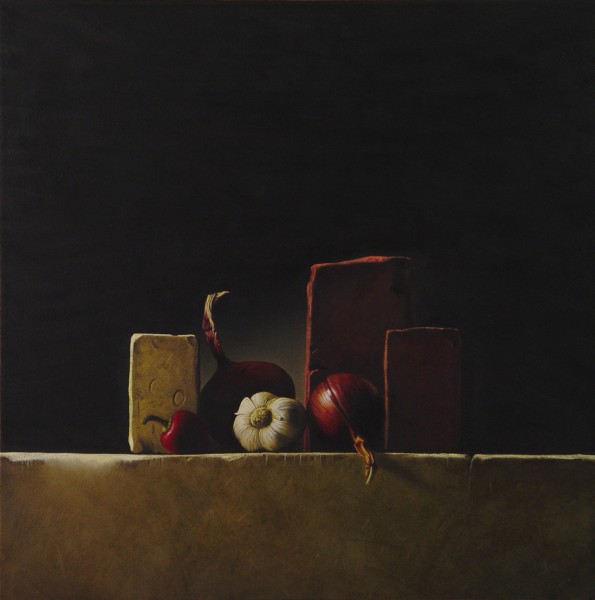
The advance of these new Irreal Painters upon hyperrealism—against which their work reacts and from which it grew—may be seen in their successful attempts to restore objecthood to the position of the theme of a painting, by expunging all traces of anecdote from the work. Along with this tendency, these painters have recognized that for the viewer, simplicity only emerges from a canvas through the mediation of the utmost technical sophistication; and this is why, in their studios, so much manipulation of things and images has taken place before any pigment is applied to a canvas.
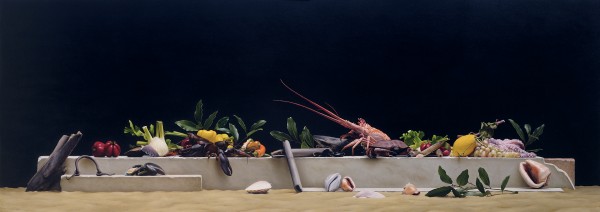
While de Biasio’s more traditional still lifes observe the genre’s conventions, we would be mistaken to infer from this the espousal of an achieved prosperity, tranquil and secure, à la the Netherlandish Golden Age. You have to ask how the pictures engage your private stock of skills and memories and habits; who needs what they’ve already got? We’re not memory banks to be crammed with information: the painting knows the eye, knows the way we see. A common and telling sight in produce markets, for example, is the stranger who regards a food item with the sense that it provides a unique sort of data about the society in which it is sown, grown, harvested, processed, distributed, sold, purchased, prepared, cooked and consumed. Looking at fruit and vegetables is a way of dishing on society, if you’ll pardon the expression. This gossipy, almost tabloidesque glimpse into an intimate domain reveals what is and isn’t the case, in a way that no other inquiry can; and when such an insight reaches us by way of a fictive gaze that’s been put forward by a still life painter, its exposures are doubly revealing—and this is multiplied many times over yet again when the painter is Italian, his country troubled by the third year of a recession, with total unemployment at twelve-point-six percent and youth unemployment at forty-two percent, and with anti-austerity protests surging into clashes against the police. In such a state of affairs, a picture of foodstuffs that aren’t staples embodies an articulate silence indeed, both palpable and ethereal in its gorgeousness. And the choice of items ramifies further as well: most of these edibles can’t be kept in cold storage for long, they are native to the region, they’re instinct with Mediterranean civilization and culture, they’re ancient and new.
These things (peppers, tomatoes, onions, persimmons, grapes, lemons, plums, cherries, pears, blueberries, apples, pomegranates, lobsters, crabs, octopi, twigs, leaves, driftwood, marble, stones, shells, sand, wax paper) are objects that stand in distinct if difficult relation with their subjects (us)—taken into the sensorium via perspectives and sizes which propose a scaled grandeur, situated as far from monumentality as it is from miniaturism, eschewing both sublimity and quaintness. The camera angles and stretcher dimensions take their place in a procedure that amounts to a series of safeguards against the all-too-human instinct for hyperbole. Technical details direct the artist’s energies—of which there are vast reserves—and moderation, judiciousness and tact indicate a temperament that’s not overeager to dispense with the complexity of its expression, or to stand exposed as anything but a single worker among many in a shop where images are made.
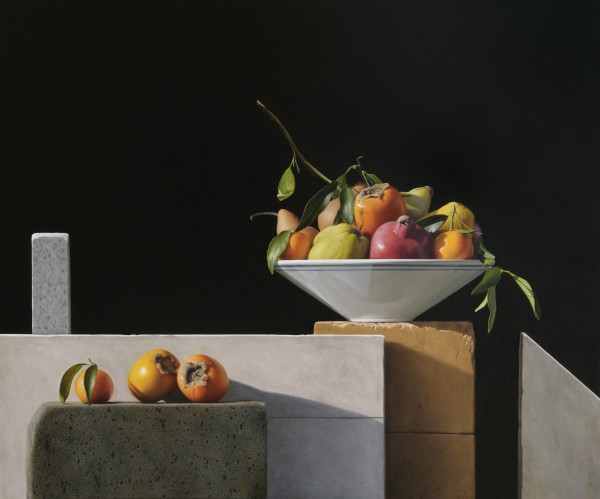
The presence and the character of light in these paintings can’t be overemphasized. The earliest available digital still life images (the untitled canvas #7 for instance) admit a dim and severe Caravaggesque luminosity, from a source located somewhere outside the picture plane, moving into an enclosed and oppressive pictorial space, a confined gloom, that has the somber effect of pushing objects up close and into a shallow foreground, uneasily; while in several later pictures (such as Vortical Being), a cool diffuse gleam descends evenly throughout and scatters its justice impartially over all, enfolding fruit and ware and marble in an effulgence that bespeaks an equable directing of the attention outward toward both organic life and the works of humankind: it’s a light in which ordinary objects seem again to possess luminescence, as they were once thought to—marine, Northern, and tolerant. This quality reaches its most eloquent and sensuous elaboration in the astonishing Marea, before maturing into a kind of souvenir of infinity in Autumnal Offering with the warm declining glow of a melancholy resignation and a bountiful harvest. Altogether these several types of light unite with a newfound color sense (de Biasio notably cites Raphael and Titian among his inspirations), and a surety and concision in Still Life #116, absolutely de Biasio’s masterpiece to date, a magnificent statement, with its piquant dailiness, its seeming naturalness, its acuity, its dignified vibrancy, its easy way with commerce, its gentleness of cast shadow, its valediction to—and critique of—the (hyper)real, its intimation of decay and death.
Even aside from de Biasio’s technical virtuosity, the anterior facts that underpin any given picture are so far from anything we can construe as personal that we’re forced to recognize the paintings’ oblique relationship not only to nature but to identity as well. This is a painter who practices still life as the production of a likeness not of things but of the conversation between psyche and intellect, a representation that doesn’t avoid unflattering tones, or strike flattering ones. In the same way that our optical equipment supplies bulk and heft to the space between two emphatically drawn lines, and complements an insistent red with a green of its own, so too does the preconscious mind provide the subject-object transformation of a thing on a canvas with thematic coordinates that are commensurate with the emotional tones it finds there. This is totally different from painting that “tells a story.” As a student at the Fine Arts Academy of Rome, de Biasio wrote his thesis on Gustave Moreau, a copy of which is now housed in the Gustave Moreau Museum in Paris. De Biasio remarks: “Obviously in my recent work it is very difficult to detect my interest in Moreau but he was surely one of the artists who contributed the most to my growing passion for art.” For Moreau, a painter of mythological and Biblical scenes, the context was a crisis of religion, as the new rationalist doctrines of his day attacked established articles of faith; his theme was a desire that had not been corrupted into lust. In light of Moreau’s impact upon this artist, we may conjecture that the overarching context of De Biasio’s art is the silhouette of bourgeois behavior as it mutates under globalization, and that his theme is a desire that hasn’t been commodified. True, the combined effects of mechanized industry and centralized secular authority have produced the new conformism that’s obvious to everyone, but the disturbing presence of such sameness in the visual domain of our lives, in the most quotidian of things, isn’t easy to perceive, let alone envision. De Biasio depicts this presence—or rather, this absence—with a traditionalism and a reticence that evade the ready replies of those who remain spiritual casualties, those who are the theme and who therefore can’t pick up on it, or still others again, who dismiss the systemic dread of these days as deluded or childish, and instead eulogize consumer experience with references to prestige food, prestige clothing, prestige art, and so on.
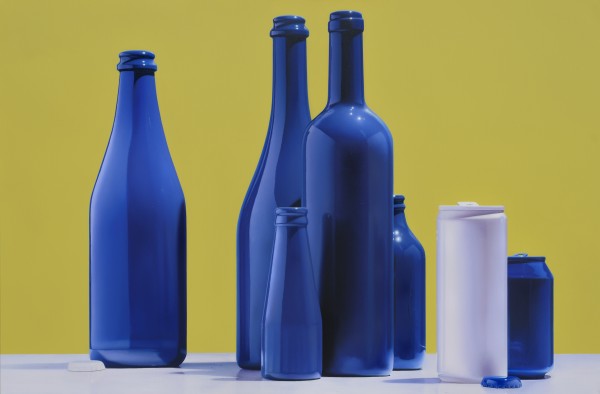
Delightfully, with the elaboration of the No Logo series, the implications of de Biasio’s thesis on Gustave Moreau begin to find an articulation that would be hard to ignore even if it weren’t so thoroughly enchanting: the self-conscious academic paganism of Moreau’s illustrations from the Greco-Judaeo-Christian mythological corpus lent a fragile embodiment to the intense collective nostalgia of a wildly insecure moment. His figures are already throwbacks—way back. Biasio’s paintings are really not still lifes at all of course, but moments, scenes in our own mythological narrative. It is both cruel and generous that the nostalgia and mythology, even the narrative, all only seem to have been excised, made conspicuous by their absence.
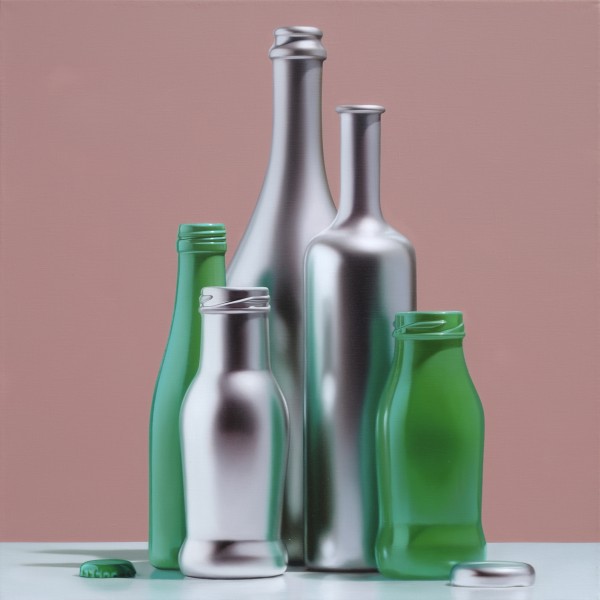
Of this next series following the still lifes, de Biasio writes: “As you may know, No Logo is an essay written by the Canadian journalist Naomi Klein. The book is about branding and the no-global movement, of which No Logo is considered one of the main reference texts. I decided to place my project No Logo against this background.” Klein’s thesis in No Logo (1999) is that the drastically increased wealth, political influence, and cultural sway of multinational corporations, which for better or worse we now recognize as normal, have come to pass according to the pronouncements of certain economists and marketing professionals, who predicted back in the mid-1980s how the success of any company on a worldwide scale would depend upon its ability to produce not only material goods but also a brand which could conceptualize its products for a mass consumer audience according to standardized socioeconomic status signifiers. The facts have borne Klein out, and then some. To see that this occurrence has had tremendous consequences for artists and art lovers, we may turn to no less distinguished an art periodical than the Wall Street Journal: “‘People have a concept of how an artist works—they imagine Jackson Pollock pouring paint over a canvas, they definitely don’t imagine a man in an office in a suit thinking up ideas,’ said New York artist and former [Jeff] Koons studio assistant Jaclyn Santos. ‘To [Koons], it’s not about making a work physically, it’s about making the idea.’” By divorcing himself from the physical workmanship of art, the artist-as-businessman-as-iconoclast, ultramodern and slick, beats out the primitivist, obsolete, semi-articulate bohemian, with his baby paint set (but no easel), in a zero-sum spectator-sport battle over the spoils of twenty-first century capital: a global art world for the neoconservative millennium, made up of inseparable binary pairs ruthlessly pitted against each other by a sublime and malignant Nature. And the victor, a recipient of the U.S. State Department Medal of Arts—able to bypass the traditional material procedures of art by outsourcing them to his staff while blithely traipsing along en route to material wealth—delivers a foolproof prescription for success in this arena; it turns out that the rest of us could all win, too, exactly like him, if only we’d just relax. From The New Yorker: “I believe that my journey has really been to remove my own anxiety. That’s the key. The more anxiety you can remove, the more free you are to make that gesture, whatever the gesture is. The dialogue is first with the artist, but then it goes outward, and is shared with other people. And if the anxiety is removed everything is so close, everything is available, and it’s just this little bit of confidence, or trust, that people have to delve into.” In Naomi Klein’s words, this anxiety-free gestural liberation of commercial art (USD $54 million for Balloon Dog [Orange] at Christie’s in 2013) sports the guise of—that’s right—“the impenetrable shiny surfaces of branded culture.” The mask has long since fused with the face that wears it. The high media profile of megatrend amalgam art inflates the Multiple and the Readymade of yore into an absurd caricature, fetishized repro tech where all emotions are constants in a logical system, and bathos rules in a particolored leisure park where fun is coextensive with one’s ability not to get sidetracked by bothersome reflections, questions, doubts, misgivings—in short, by any impulse which might give rise to nuance: because that’s the one thing which would turn the pocket void of this spastic milieu into an abyss gaping underneath the Big Bubble and engulfing its love in darkness when it bursts and every last dime rains down just like real money.
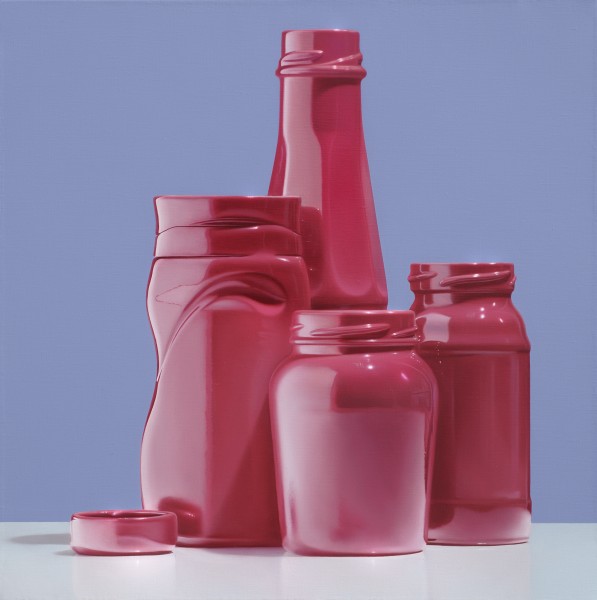
It comes as no surprise to learn that de Biasio’s extended period of residence and study in New York, while working as an assistant to painter Mark Kostabi, helped give rise to the No Logo paintings: “I have to say that the Kostabi job was fantastic,” he recalls. “It allowed me to live deep in the New York artistic atmosphere and become familiar with a way of working which is totally different from the one I knew in Italy. Moreover I got to know a lot of artists. The New York experience left a tangible sign in my subsequent work, particularly in the chromatic evolution.” We see this development in No Logo #91. If such color choices indicate an American palette (he has mentioned Thiebaud as an influence), then the character of the composition as a whole is markedly Italian: “I give a lot of importance to the compositional technique of my still lifes,” de Biasio continues. “Every single object has to be positioned in the right place. There must be a sort of ‘dialogue’ (chromatic and volumetric) between the elements, and here there is the significance of Morandi’s lesson.” The small, almost shimmering tableaux of tightly grouped vessels in muted pinks, creams, yellows and greens, painstakingly rendered by the assiduous and withdrawn master Giorgio Morandi—who painted them as if in an act of prayer, and who famously claimed that there is nothing more surreal than the real itself—might seem to be a far cry from the high polish of the No Logo series, but the effect of Morandi on de Biasio’s process can be discerned in his paintings’ utter lack of cleverness, in their unironic, declarative fontality, as in No Logo #92, #93 and #100.
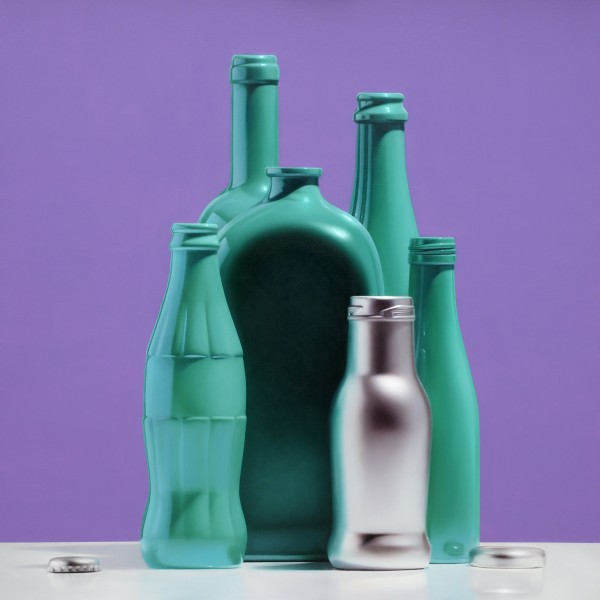
The artist recognizes not only that he can’t help expressing his own time, but also that he does so tangentially as it were, hardly beside the point or from outside, but rather complementary to his age, apposite. In the case of this painter particularly, we witness a supreme intuition into the evolving character of twenty-first century cognitive style: here are paintings that don’t just acknowledge the end of chemical photography, and the advent of the painter’s studio as a Dark Room where all manner of implements establish the conditions under which at last the artist may track and study the behavior of paint instead of the conventions of representation: much more, de Biasio presents us with these works of his as one who is exceptionally aware of the craft of painting, yes, but also of its advantageous position vis-à-vis his society and its culture. He has contributed a piece to that odd genre, the Artist Video—but as you might expect, he completely ignores its potential as a marketing tool and opts to use only muzak for the soundtrack and to depict not his face but only his hand as it puts paint on linen with a fan brush: a gentle but firm counterstatement. When we watch this clip on the screen of a device, its imagery welcomes us into a painter’s studio, where we imagine that the disembodied hand we see applying paint to a canvas is really our own; in the same way, when we view one of the No Logo paintings exhibited on a gallery wall, the rich and subtle real paint immerses our minds in a solution of dark energy, where we dissolve into the aether and breathe a spirit that infuses the cosmos with force and motion, so that we see the way light dwells, and bind the sweet influences of the Pleiades, and loose the bands of Orion.
The viewer, the subject, looks at the paintings, the things in the paintings are objects in the viewer’s life but they aren’t the object of the painting, the object of the painting is the paint, if not then one remains merely a viewer and never becomes the subject. It’s a contract, both sides have to try. The painter whose awareness of these conditions is acute runs the risk of being too self-conscious about it, overdoing the modeling of paint and losing the viewer’s attention. De Biasio’s allusion to “a certain expressive tension” in his recent works indicates a tension not among the things depicted but between the distinct reality of the pigment and a performance of illusionism, it’s a tension that makes our perception flicker between paint and painted. He creates a representation of the pictorial representation of optical facts, a sophisticated performance, for sure.
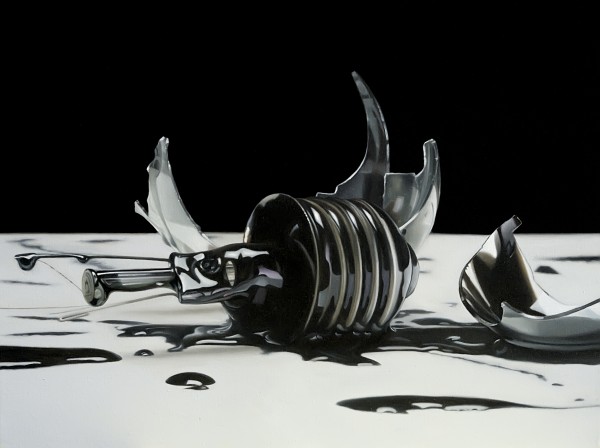
The encoded figural themes known in the visual arts as Pathosformel or feeling-forms have gathered together into conventions over centuries, but they only emerge in an artwork in spite of the Will, as philosophy defines it. It’s not that pretense to knowledge of every possible context would offend modesty (because some artists are overconfident) but rather that, if one does not “lose oneself” in making the artwork, the seed of narrative that one’s content contains will not have a chance to grow, shed its casing and become a theme. Still Life is called Nature Morte for a reason. As a genre it automatically gives rise to a theme known in the sciences as the Observer Effect, in philosophy as das Ding an Sich or “the thing in itself” (Kant and Nietzsche) and as the phenomenon and noumenon, or Form and Idea, of Plato.
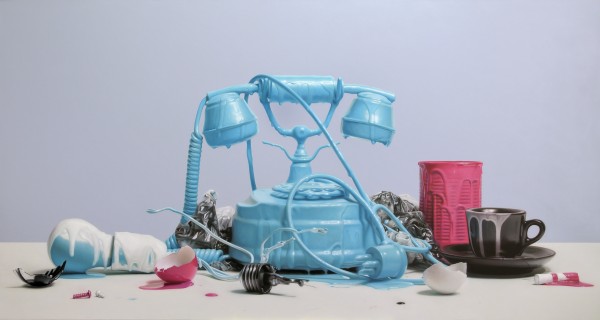
De Biasio’s latest project, the nascent Dripping Memory series, bears the mark of an analytical poetics, directing an indulgent but exacting gaze toward the tropes of canonical post-surrealist dream logic in its passé approach to rendering unconscious processes. “In Dripping Memory, objects are immersed in a varnish that forms a patina,” the painter tells us. “This covers the object, modifying the outline, as if the memory of that same object were disappearing.” (See Dripping Memory #114, #115, and #118.) We may be forgiven for surmising that a corollary of this most recent series abides in the lengthy agglutinating of cathexes by the libido and their subsequent identification in psychotherapy. An icy, almost colorless zone opens before us in these pictures, strewn with obsolete gadgetry, disused furnishings and broken hardware, all covered in goo of various hues that appears to have dried and hardened over each piece of junk into a gleaming shell even as it oozes down onto the surface underneath. The Dripping Memory paintings are the very picture of a Freudian Unheimliche, “the uncanny,” in their imaging of what you might call the psychic viscosity of things.
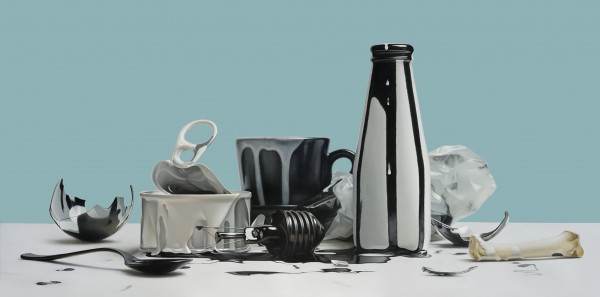
At a minimum it is reasonable to surmise that despite the trendspotting ambitions that prevail in right-thinking critical and social media circles of art theory opinion (“highbrow taste, mass appeal,” to be sure), an apparent lack of emphasis in an oil painter’s treatment of his motifs—which moreover he has chosen for their affect, as emotive stimuli—far from testifying to a crisis in painting, proves its health beyond cavil finally by asserting that the integrity of human life dwells within a kind of non-heroic ambience, a potent aura of thought. It’s not just that pigment isn’t a consequence of things any more than words are, but also that once this fact has been grasped, the artist has to synthesize a plurality of extrinsic elements he only now sees in their interrelations, as if for the first time, each one by itself and every one together. If there is any vehemence to be found in the art of David de Biasio, surely it resides within this aesthetic and in his fixity there.
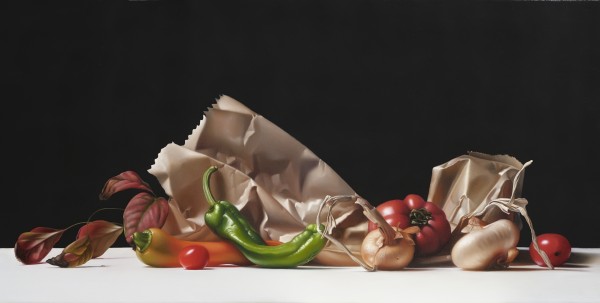
–Erik Noonan
Sensitive Skin 13 available here in PDF format here for just $4.95, or get the full-color print version via Amazon and select bookstores.
Painting